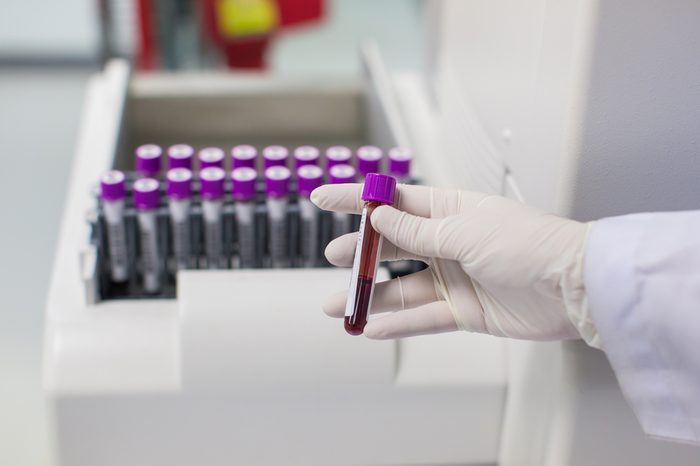
You’re ovulating
Vaginal discharge changes throughout your monthly cycle. You may notice a difference in the consistency, texture, color, amount and even the smell, says Nicole Scott, MD, an ob-gyn at Indiana University Health in Indianapolis. The most noticeable of these changes is during ovulation. “In preparation to help the sperm reach the egg, your discharge will become thin, slippery, and even ‘stretchy’ like egg whites,” she says. If you’re trying to get pregnant, the best time to have sex is when you notice this type of discharge. (Okay, not that sexy, but if you want to conceive…)

You’re pregnant
Because vaginal discharge is so closely tied to hormonal fluctuations, it’s no surprise that pregnancy—nine months of one big hormonal fluctuation—can alter it. “Many pregnant women notice an increase overall in discharge and it may take on a white-yellow tinge,” Dr. Scott says.

You’re in labor
If you’re pregnant and suddenly notice an uptick in mucous-y discharge, congratulations: You’re about to have a baby! “As the cervix dilates in preparation for delivery, mucous discharge increases and may indicate labor is beginning,” Dr. Scott explains, adding that some women even experience a large “chunk” of discharge, often referred to as the mucous plug. But don’t get too excited just yet as the beginning stages of labor can take a long time—days, and sometimes even weeks. If you have a lot of mucus coming out of your vagina, check with your doctor and he or she will be able to give you a good estimate of how close labor is.

You have an infection
Most women are trained from puberty to recognize the hallmark signs of a yeast infection: Itching, burning, and that telltale “cottage cheese-like” vaginal discharge. But yeast isn’t the only type of bad bug that can take up residence in your lady parts, Dr. Scott says. Bacterial vaginosis is a super common bacterial infection characterized by a vaginal discharge that is white-gray in color and has a fishy odor. If you have any of the above symptoms or notice itching, swelling, pain, or just a marked change in your genitals, make an appointment stat to get checked for infections, she adds.

You have an STD
Gonorrhea and chlamydia, two sexually transmitted diseases that are reaching epidemic proportions these days, may cause your vaginal discharge to change in color, amount, or smell. Unfortunately, more often than not these two are asymptomatic, meaning that you won’t know you have them until they show up on a test. (Another reason to stay on top of your yearly check-ups.) There is one STD however, that makes a major mark in your undies: Trichomoniasis is characterized by “frothy green and yellow” discharge, according to Dr. Scott. For the record, “frothy” is never a word you want to be associated with your genitals. Keep up with your sexual health with an at-home STD test subscription.

You’re turned on
One of the most noticeable side effects of good foreplay is an increase in wetness in your vagina. “Vaginal fluids act as a sexual lubricant,” Dr. Scott says, “so as a woman becomes aroused she may notice an increase in thin, clear liquid.” It’s certainly nothing to worry about and, because it can increase comfort and pleasure, may be the one type of vaginal discharge to really get excited about! Here are 31 natural libido boosters to help you have better sex.

You eat a healthy diet and work out
“Anything that makes your breath smell can make your vaginal discharge smell,” Dr. Scott says. This includes good-for-your-body-but-bad-for-your-breath staples like garlic, hot peppers, onions, and asparagus. In addition, a good sweaty workout will make you smell like sweat everywhere, even (especially) in your crotch area. Neither of these smells are anything to worry about, she says.

You’re dehydrated
Just like dehydration can cause your urine to turn a darker yellow, so can it make your vaginal discharge take on a yellowish tinge, Dr. Scott says. She adds that sometimes urine will mix with discharge—say, on toilet paper or in your underwear—which will also give the discharge a yellow color. Drink more water and you’ll be fine!

You have a rare cancer
Most cancers, even those of the female reproductive system, do not have any effect on vaginal secretions, Dr. Scott says. However, there is one rare form of fallopian tube cancer that is characterized by a large increase in watery discharge. It’s very unlikely you have this type of cancer but any time you notice a marked change in the amount or type of your vaginal discharge, it’s time to call your doctor, she adds. These are cancer symptoms women are likely to ignore.

You’re in menopause
Menopause can make you feel like you’re possessed by hormonally belligerent aliens—they don’t call it “the big change” for nothing! And one of the things that will change is your vaginal discharge, Dr. Scott says. “It will become drier, lessen in amount and may make you more susceptible to infection,” she explains. Just another fun part of womanhood no one warns you about!

You’re totally normal
Many women do not know what normal vaginal discharge looks like and become unnecessarily worried, Dr. Scott says. “What’s ‘normal’ will vary from woman to woman but in general discharge will be clear mid-cycle and turn white right before your period. But it’s important to pay attention to how it changes throughout your cycle so you understand what is normal for you and your body,” she says. “And whatever you do, don’t try to get rid of it by douching! In fact, never douche, ever!”